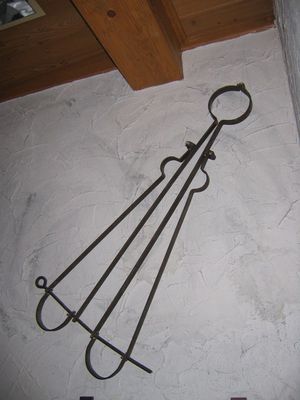Scavenger's daughter
The Scavenger's daughter was a type of torture device.
History
It was invented as an instrument of torture in the reign of Henry VIII by Sir William Skevington (also known as William Skeffington), Lieutenant of the Tower of London. It was an A-frame shaped metal rack to which the head was strapped to the top point of the A, the hands at the mid-point and the legs at the lower spread ends; swinging the head down and forcing the knees up in a sitting position so compressed the body as to force the blood from the nose and ears.
The Scavenger's Daughter was conceived as the perfect complement to the Duke of Exeter's Daughter (the rack) because it worked the opposite principle to the rack by compressing the body rather than stretching it.
The Scavenger's Daughter is rarely mentioned in the documents and the device itself was probably not much used. The best-documented use is that on the Irishman Thomas Miagh, charged with being in contact with rebels in Ireland. It may be in connection with Scavenger's Daughter that Miagh carved on the wall of the Beauchamp Tower in the Tower of London, "By torture straynge my truth was tried, yet of my libertie denied. 1581. Thomas Miagh."
It is also known as Skevington's gyves, as iron shackle, as the Stork (as in Italian cicogna) or as Spanish A-frame. Further it is known as Skevington's daughter, from which the more commonly known folk etymology using "Scavenger" is derived. There is a Scavenger's daughter on display in the Tower of London museum.
See also
- Captain's daughter, referring to the naval Cat o' nine tails
- Gunner's daughter, the gun to which young seamen were positioned and often strapped down to be publicly flogged on the posterior.
Chat rooms • What links here • Copyright info • Contact information • Category:Root
